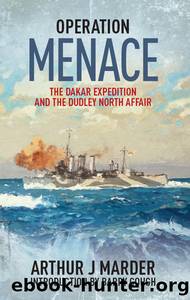Operation Menace by Arthur J. Marder

Author:Arthur J. Marder [Marder, Arthur J.]
Language: eng
Format: epub
Tags: History, Military, Naval, Maritime History & Piracy
ISBN: 9781848323926
Google: _6i6DQAAQBAJ
Publisher: Casemate Publishers
Published: 2016-06-30T00:46:04+00:00
At 4.48 the Westernland stopped near Cape Rouge, 7½ miles from Rufisque.
The sea was calm and the chances for landing were, in Spearsâs judgement, âuniqueâ. On the other hand, de Gaulleâs transports were being shadowed by a French aircraft at 2,000 feet. (The fog had lifted at that height). Presently Major Watson came running up with a signal from the Admiral (Ark Royal aircraft had sighted the cruisers and were reporting their movements) that two cruisers had broken out of Dakar and were but two miles off, and that the British ships were unable to afford any protection. âDe Gaulle knew as well as I did,â writes Spears, âthat if the cruisers opened fire on us, defenceless and undefended as we were, it would mean a holocaust. Our ship, packed with troops, would burn like a torch until it sank into that shark-infested sea.â19 At Spearsâs suggestion, towards 4 de Gaulle turned away to sea. What were the two cruisers doing in the area?
At 4.20 p.m., in response to a report from a patrolling aircraft (3.35) which had sighted the transports, accompanied by light vessels, some 12 miles to the south-west of Rufisque, heading east, the super-destroyer LâAudacieux had sailed out to investigate. She was followed by the cruisers Georges Leygues (Lacroix) and Montcalm and the super-destroyer Le Malin, which force threatened the approach of de Gaulleâs sloops to Rufisque. As the Audacieux passed out through the gate in the boom between Gorée and the shore (i.e. east of Gorée) that had been created that morning, she was sighted by the Australia and the destroyers Greyhound and Fury at 4.24 and engaged minutes later at point-blank range (about 4,000 yards). She was then smothered by British fire. An 8-inch shell blew away her bridge and instantly converted her into a blazing wreck. The Second-in-Command had two torpedoes launched, fearing that they might explode. He was merely getting rid of them. They were not aimed at any particular ship and hit nothing.
The sloop Surprise, though under British fire, succeeded in rescuing 186 men of the Audacieux, among them about 100 wounded; 81 men had been killed. The ship burned for more than 36 hours. The flaming wreck drifted slowly to the shore, where it ran aground the next day between Rufisque and Popenguine. (Refloated in March 1941, the Audacieux managed to reach Bizerte, where she was finished off by American planes in 1943.)
The French cruisers and the super-destroyer, which had sailed at 4.40 to reconnoitre the Bay of Rufisque, had heard the firing, but did not realize what was taking place less than 3,000 yards away. They arrived in Rufisque Bay after the British scouting forces had left and a few minutes before the Free French ships appeared. They passed to the north of Résolue Bank and, at 5.20, when one mile from Rufisque Lighthouse, turned around without discovering anything, and at 5.50 were back in Dakar harbour. The exceptionally poor visibility near the coast had prevented the French ships from
Download
This site does not store any files on its server. We only index and link to content provided by other sites. Please contact the content providers to delete copyright contents if any and email us, we'll remove relevant links or contents immediately.
| Central Africa | East Africa |
| North Africa | Southern Africa |
| West Africa | Algeria |
| Egypt | Ethiopia |
| Kenya | Nigeria |
| South Africa | Sudan |
| Zimbabwe |
Goodbye Paradise(3442)
Men at Arms by Terry Pratchett(2681)
Tobruk by Peter Fitzsimons(2373)
Arabs by Eugene Rogan(2193)
Pirate Alley by Terry McKnight(2126)
Borders by unknow(2115)
Belonging by Unknown(1727)
It's Our Turn to Eat by Michela Wrong(1588)
The Biafra Story by Frederick Forsyth(1555)
Botswana--Culture Smart! by Michael Main(1482)
The Source by James A. Michener(1454)
A Winter in Arabia by Freya Stark(1444)
Gandhi by Ramachandra Guha(1426)
Coffee: From Bean to Barista by Robert W. Thurston(1419)
Livingstone by Tim Jeal(1389)
The Falls by Unknown(1369)
The Shield and The Sword by Ernle Bradford(1310)
Africa: Altered States, Ordinary Miracles by Richard Dowden(1291)
Egyptian Mythology A Fascinating Guide to Understanding the Gods, Goddesses, Monsters, and Mortals (Greek Mythology - Norse Mythology - Egyptian Mythology) by Matt Clayton(1276)
